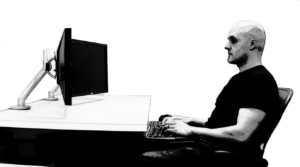October is Ergonomics Awareness month, and CSU has free resources to help employees avoid work-related injuries.
Although ergonomics can and should be a focus year-round, October’s ergonomics awareness month is when we should pay special attention to human factors and ergonomics. From office work to the laboratory, custodial work to dining services, animal care to work in the trades, ergonomics applies to all areas of work — even tasks performed at home. Ergonomics is the science that seeks to minimize or eliminate exposure to injury risk factors by designing tools, equipment, workstations and processes to meet the capabilities of humans. Quite a concept. If the equipment, tool, task, workstation or environment exceeds human capabilities, we are likely to suffer. Whether the suffering is due to an injury or loss of productivity, these are concerning nevertheless.
What everyone should be focusing on regularly is how we can identify “the problems.” Finding the  issues or problems and correcting them by making proper changes should be the goal. This does not mean simply making changes to lifting technique, sitting up straight in your chair, or rotating job tasks between employees. Ideally, engineering controls or changes to the equipment, tools, and workstations need to be made, as these have been found to be most beneficial and impactful.
issues or problems and correcting them by making proper changes should be the goal. This does not mean simply making changes to lifting technique, sitting up straight in your chair, or rotating job tasks between employees. Ideally, engineering controls or changes to the equipment, tools, and workstations need to be made, as these have been found to be most beneficial and impactful.
Pinpointing the issue
Identifying the problem can be the hard part. Somewhat simple deviations to posture can have a detrimental effect and lead to the common injuries you have likely heard of such as carpal tunnel syndrome or tendonitis. Be aware of your job, tasks, tools, equipment and environment. If something doesn’t fit correctly, creates an awkward posture, requires excessive force (such as heavy lifting), especially when repeated or performed for extended durations, think of ways to change it. What can be done differently? How can this be made easier, faster, safer?
Although ergonomics is commonly thought of as a work-related solution, did you know that ergonomics can also be applied at home? Of course it can. Why reach excessively for a heavy mixing bowl on the top shelf? Is there a tool to make it easier? Sure! It’s called a step stool. Ergonomics is everywhere.
Unfortunately, ergonomics-related injuries (such as overexertion and repetitive motion) take time to develop (weeks, months), and when an injury takes place, it may take weeks or months to heal. Tendon-related injuries can take 20-plus times longer to heal than muscle-related injuries. That is pretty significant. So, why not prevent these? We’ll point back to the risk factors: forceful exertion, awkward posture, frequency and duration. If we find and correct these in excess before the pain and discomfort, we’ll likely prevent the injury.
Although ergonomic-related injuries are at issue at CSU, as well as throughout the country, the good news is that there are free resources for CSU employees.
Ergonomic evaluation
Consider having an ergonomic evaluation, regardless of your job. You do not need to work on a computer to have an ergonomic evaluation. In fact, most of CSU’s ergonomic injuries are not related to computer work. Most commonly these are related to lifting, which is true for the rest of the country as well.
Visit the ergonomic evaluation website for more information and to submit an ergonomic evaluation request.
An ergonomic specialist will visit your work site and help identify potential issues and make recommendations to mitigate the problem. This can be done with your computer workstation, laboratory, etc. Evaluations are free to all CSU departments and employees.
Training
In addition to an ergonomic evaluation, all employees are encouraged to receive proper training. Click the link below to access ergonomic training sessions. There are both online and instructor led sessions on office ergonomics, back safety and slips trips and falls. Job specific custom designed ergonomics training can also be developed. See the website for additional details.
Matching Funds
As part of the office ergonomics program, the Office of Risk Management & Insurance has developed a matching funds program. This program offers potential funding of up to $500 dollars per employee in matching funds (50 percent of total equipment cost) to modify existing office computer workstations to provide departments a cost-effective method of injury protection. For additional information, access to the matching funds procedure, application and more, go to the website.
Contact the office for additional help and to have questions answered:
(970) 491-2724
Frank.Gonzales@colostate.edu
http://rmi.prep.colostate.edu/ergonomics/